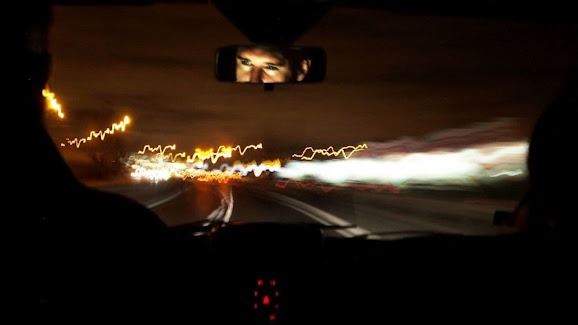Search This Blog
This is the blog of the author, L.C. Douglass, concerning art, literature, poetry, and writing.
Featured
- Get link
- X
- Other Apps
A Farewell to David Lynch 1: At the Traffic Stop
When David Lynch died on 16 January 2025, I stated that I would later comment on his artistic influence on my work. I'll break my thoughts down in a series of posts, not least with reference to my Patreon series on the occult symbolism of traffic lights.
Above all, Lynch introduced me to two things that all writers should know when trying to portray our layered reality:
- A juxtaposition of dream states, illusions, lies, truth, reality, extratemporal and extradimensional interlopers all in one linear narrative, which is a form of surrealism.
- Ironically, Lynch also introduced non-linear narratives at the same time to mass audiences, most notably in Lost Highway, Mulholland Drive and Inland Empire.
My understanding of the first idea - a linear narrative which juxtaposes insanity with sanity, private thoughts, nightmares, illusions, and imaginings with public identity - crystalized while watching the scene in Twin Peaks: Fire Walk with Me (1992), when Laura Palmer and her father are stuck at a traffic light. The Twin Peaks Blog described the scene, including the original filming location, here.
In the scene, the One-Armed Man's surreal warning tries to break apart the carefully-constructed illusion and denial of the Palmer family's horror. What has happened to Laura? Who did it? It's him! It's your father! But for both Laura and her father who are trapped in a compartmentalized existence, with a normal-looking surface, the One-Armed Man character - Mike - looks crazy. This is how truth looks to those who deny the truth. This was how Lynch was able to convey the truth, the lies, the abuse, the insanity posing as sanity in the Palmer family. Everything was laid out neatly a linear fashion: 1, 2, 3, 4 ....
Having studied History in university, I was fascinated by the idea that one could tell the whole history of reality. At that time, Postmodern theory rejected fixed or objective meanings, other than the very rejection meaning itself. That is, the rejection of objective truth was (hypocritically) taken as an objective truth, in a secular, self-righteous moral sense.
Beyond the domineering rejection of ultimate knowledge, any Platonic concept of an absolute or an ideal was anathema to the late 20th century intellectual establishment. In literature, dramatic moments depended upon ellipses, unexplained domestic strife, or empty spaces. I thought of Postmodern stories, films and novels which made a big deal out of leaving things hanging and unexplained. Empty moments could not be filled with higher values. This nadir, this cultural victory of emptiness, was presented with an air of smugness about anti-truth. Nothing could ever be fully pinned down.
Instead, it became more artistically acceptable to focus on the minutiae of existence. In the early 2000s, I remember reading a novel excerpt from a highly-promoted twenty-something UK writer, in which a scene focused on the pinch of the character's thong. One could become a sensation by describing tiny, gritty, grubby, nasty details about everyday reality. Beyond the artful accumulation of tactile and material moments, there was nothing one could say. It was like an artistic demonstration of Ludwig Wittgenstein's maxim on our inability to describe reality fully and accurately with language: "Whereof one cannot speak, thereof one must be silent," from his Tractatus Logico-Philosophicus (1922).
By contrast, Lynch used surrealism to explore dreams, the subconscious, the extra-dimensional, the regions carved out by lies, secrets, and delusions. Where normally this material was hidden, censored or erased to prop up a compromised, incomplete and barely-functioning reality, these terrifying truths could be placed in order alongside mundane and ordinary aspects - and alongside the illusions which concealed them. I felt that this method of telling the 'whole story' would shatter the self-deception and selective memories of self-serving egotists.
Lynch was not pleased with Showtime's editing of Twin Peaks season 3; and he immediately ordered his sound guy, Dean Hurley, to do a theatrical cut of all 18 episodes (see my related posts here and here). This weekend (5-6 July 2025), the theatrical cut, Twin Peaks Circa 2017, was shown at Metrograph Theater in Chinatown, 7 Ludlow Street, New York City. Oh, how I wish I could have been there. Metrograph has a streaming service and perhaps it will be streamed in the future.
See all my posts on David Lynch at Histories of Things to Come.
- Get link
- X
- Other Apps





Comments
Post a Comment